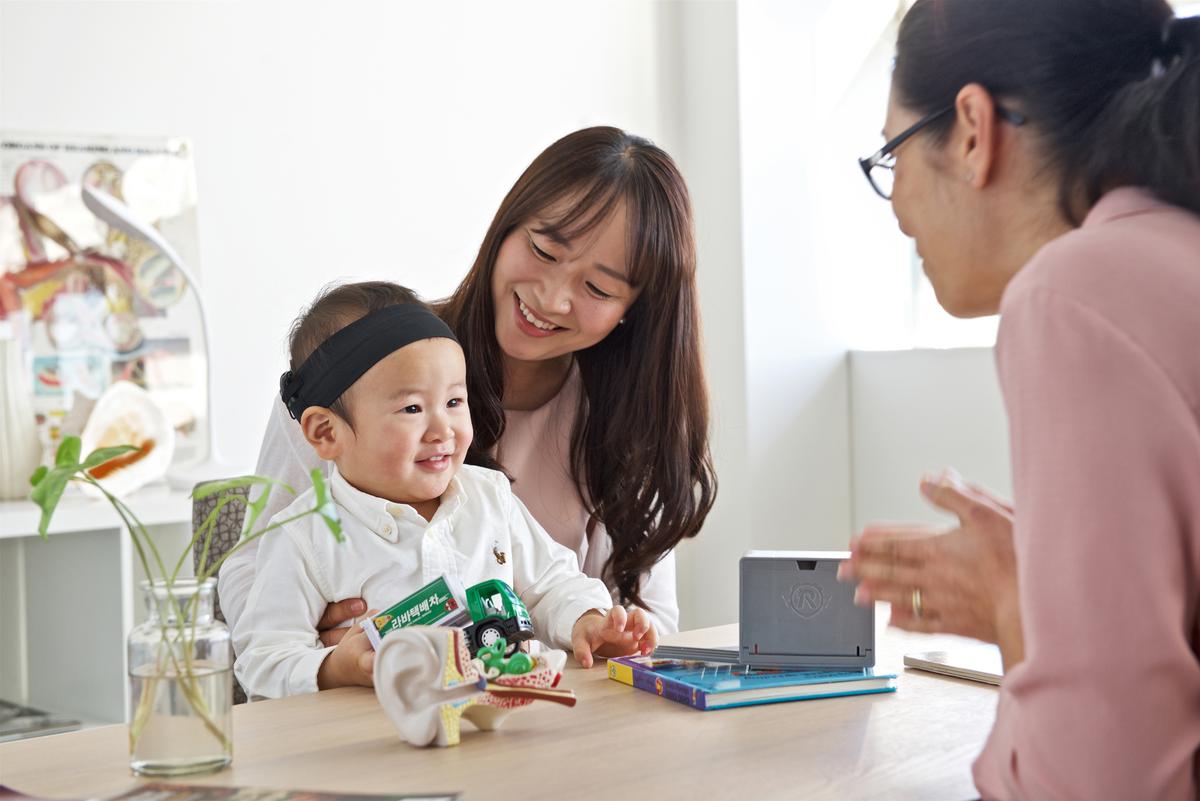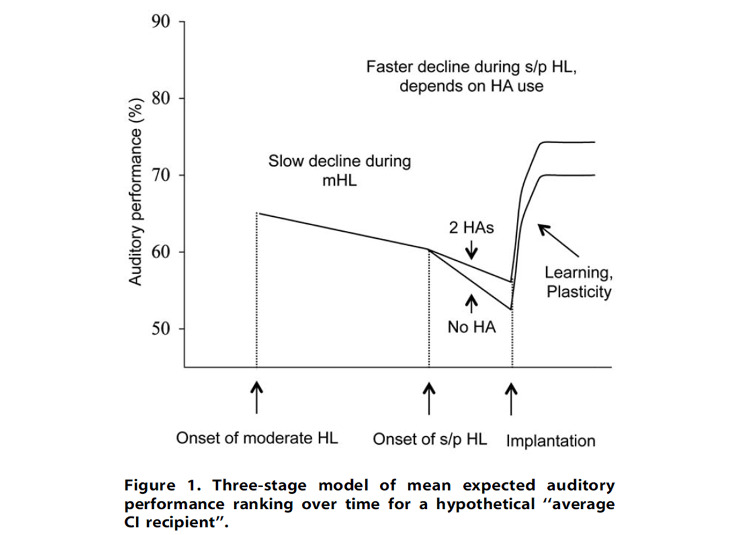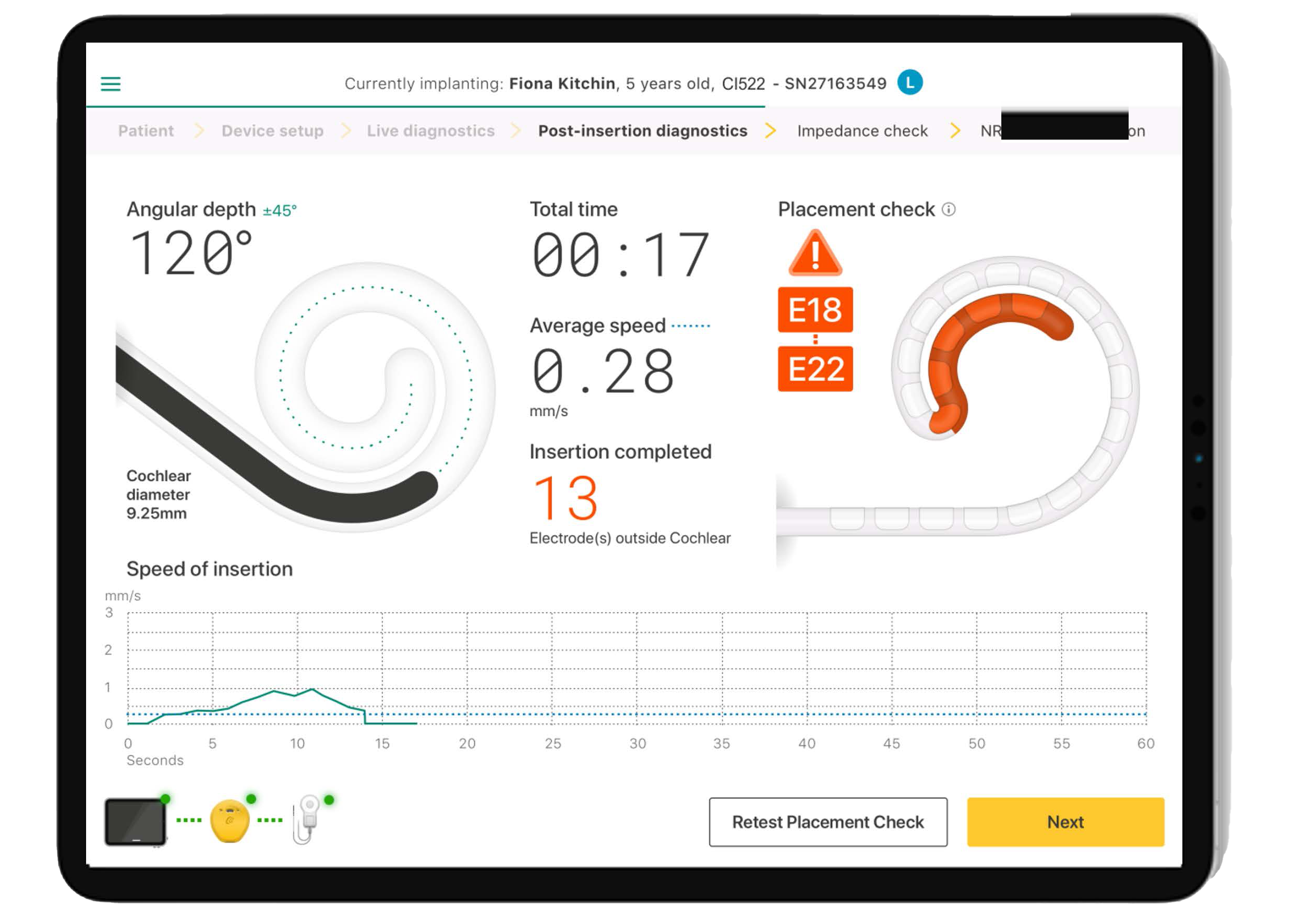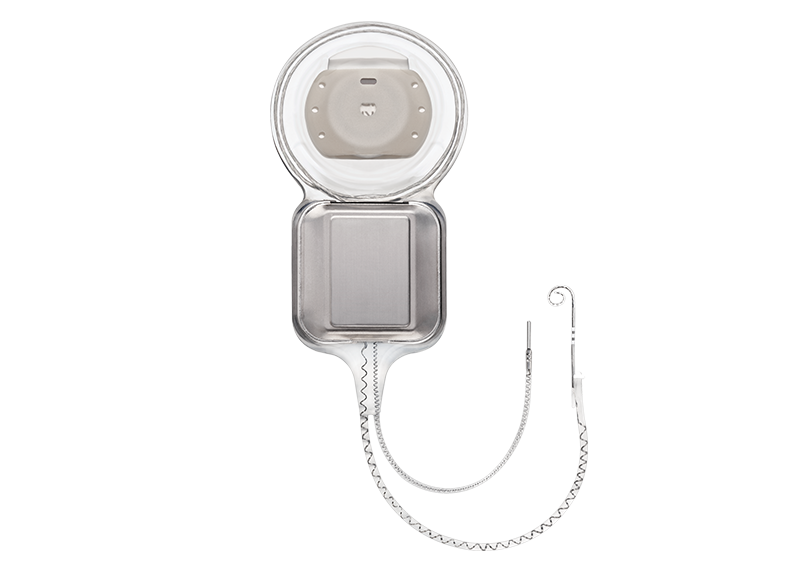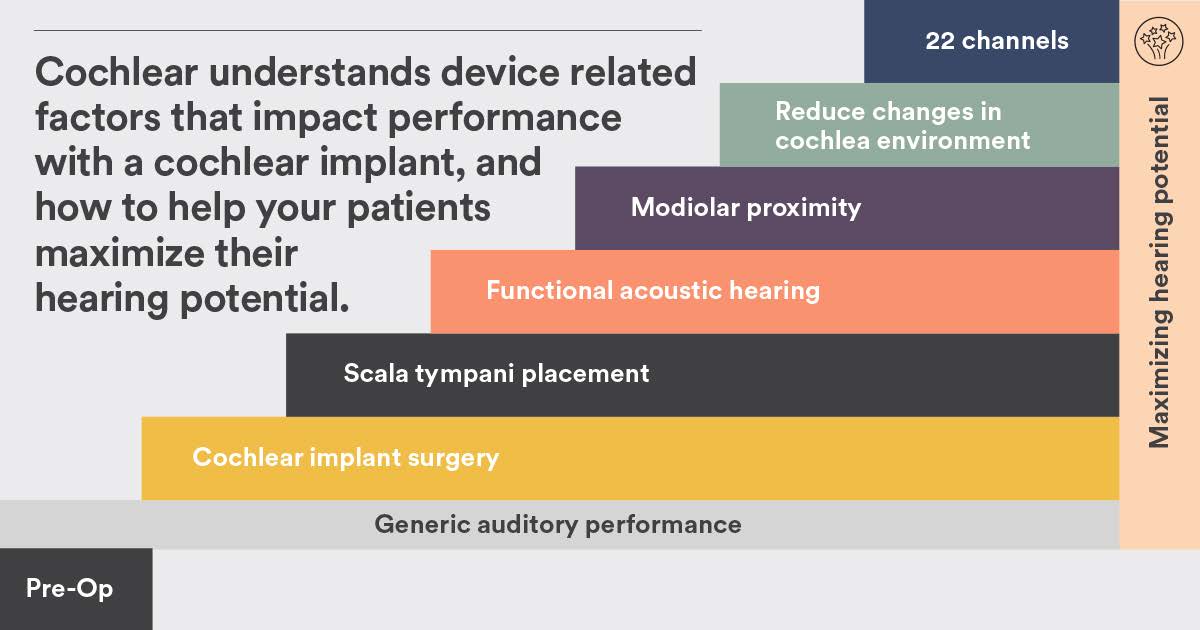What is hearing potential?
What is hearing potential?
The journey with a cochlear implant is a life long one, and every patient is unique. Factors like duration of deafness, etiology of hearing loss, neural substrate, cochlear anatomy and more all correlate to how well someone may perform with a cochlear implant.1 If any pre-op factors correlate to post-op outcomes, then each patient has a "hearing potential" they can achieve with a CI.
Cochlear™ understands those factors and integrates them into our product portfolio so your recipients have the best possible chance at achieving their maximum hearing potential. Being Inspired by a Lifetime of Hearing Performance, Cochlear has implemented slim, perimodiolar electrodes into our portfolio that allow for focused stimulation of the hearing nerve. We'll explore some of the research below.
What is hearing potential?
The journey with a cochlear implant is a life long one, and every patient is unique. Factors like duration of deafness, etiology of hearing loss, neural substrate, cochlear anatomy and more all correlate to how well someone may perform with a cochlear implant.1 If any pre-op factors correlate to post-op outcomes, then each patient has a "hearing potential" they can achieve with a CI.
Cochlear™ understands those factors and integrates them into our product portfolio so your recipients have the best possible chance at achieving their maximum hearing potential. Being Inspired by a Lifetime of Hearing Performance, Cochlear has implemented slim, perimodiolar electrodes into our portfolio that allow for focused stimulation of the hearing nerve. We'll explore some of the research below.
Considering outcomes over a patient's lifetime
Benefits of early implantation
Benefits of early implantation
There are several factors to consider that contribute to a lifetime of hearing performance. For candidates, simply receiving an implant can deliver a significant improvement in speech recognition and overall hearing and the earlier they receive intervention the better.2
Figure 1. From Lazard et al 2012
Benefits of early implantation
There are several factors to consider that contribute to a lifetime of hearing performance. For candidates, simply receiving an implant can deliver a significant improvement in speech recognition and overall hearing and the earlier they receive intervention the better.2
Figure 1. From Lazard et al 2012
Nucleus® SmartNav
Nucleus® SmartNav
Cochlear has developed intraoperative surgical systems designed to provide confidence in the OR ensuring appropriate device placement and function. Features include:
- Angular Insertion Depth
- Speed of Insertion
- Placement Check
- Impedances
- Auto and AdvancedNRT
- eSRT
- Cloud data transfer
- Implant Registration
Nucleus® SmartNav
Cochlear has developed intraoperative surgical systems designed to provide confidence in the OR ensuring appropriate device placement and function. Features include:
- Angular Insertion Depth
- Speed of Insertion
- Placement Check
- Impedances
- Auto and AdvancedNRT
- eSRT
- Cloud data transfer
- Implant Registration
Scala Tympani placement
Scala Tympani placement
Optimal placement of the implant electrode in the scala tympani also contributes to long term outcomes, with correct placement maintaining the integrity of the cochlea and helping to deliver improved hearing performance.3,4
In a US Multicenter study, all Slim Modiolar electrodes were placed successfully in Scala Tympani.
Scala Tympani placement
Optimal placement of the implant electrode in the scala tympani also contributes to long term outcomes, with correct placement maintaining the integrity of the cochlea and helping to deliver improved hearing performance.3,4
In a US Multicenter study, all Slim Modiolar electrodes were placed successfully in Scala Tympani.
Functional residual hearing
Functional residual hearing
When looking at emerging data, Iso-Mustajavari,5 Woodson,6 and Ramos7 have all found that the Slim Modiolar array allows for preservation of structures and thresholds in populations with low frequency residual hearing, with Iso-Mustajavari reporting an 11dB threshold shift at 582 days. This shows that hearing preservation is possible with the 632, which has additional benefits in electric only stimulation if patients do lose residual hearing over time.
Functional residual hearing
When looking at emerging data, Iso-Mustajavari,5 Woodson,6 and Ramos7 have all found that the Slim Modiolar array allows for preservation of structures and thresholds in populations with low frequency residual hearing, with Iso-Mustajavari reporting an 11dB threshold shift at 582 days. This shows that hearing preservation is possible with the 632, which has additional benefits in electric only stimulation if patients do lose residual hearing over time.
Modiolar proximity
Modiolar proximity
Modiolar proximity is another important contributor to effective electrical stimulation.8,9,10 Placement of the electrode close to the Modiolar wall reduces both acute and long-term trauma to the structures of the lateral wall, supporting ongoing hearing outcomes,11,12,13 only Cochlear offers a Slim Modiolar electrode which sits close to the modiolus to permit more precise and effective stimulation of the hearing nerve. In research studies, the Slim Modiolar electrode delivered better outcomes on average than a lateral wall electrode.8,9
Modiolar proximity
Modiolar proximity is another important contributor to effective electrical stimulation.8,9,10 Placement of the electrode close to the Modiolar wall reduces both acute and long-term trauma to the structures of the lateral wall, supporting ongoing hearing outcomes,11,12,13 only Cochlear offers a Slim Modiolar electrode which sits close to the modiolus to permit more precise and effective stimulation of the hearing nerve. In research studies, the Slim Modiolar electrode delivered better outcomes on average than a lateral wall electrode.8,9
Independent electrode channels
Independent electrode channels
Cochlear offers the only electrode with 22 independent channels, which may support improved speech recognition outcomes, particularly in noise.10 Having more independent channels closer to the hearing nerve also provides greater opportunity to take advantage of future sound coding strategies.10
Independent electrode channels
Cochlear offers the only electrode with 22 independent channels, which may support improved speech recognition outcomes, particularly in noise.10 Having more independent channels closer to the hearing nerve also provides greater opportunity to take advantage of future sound coding strategies.10
Cochlear is focused on long term sustainable outcomes, for you and for your patients. That's why we believe in structural preservation of the cochlea over functional hearing preservation. When you choose Cochlear you are supported by innovative hearing solutions and a partnership that will help you provide your patients with a lifetime of hearing performance.
Disclaimer
This material is intended for health professionals. If you are a consumer, please seek advice from your health professional about treatments for hearing loss. Outcomes may vary, and your health professional will advise you about the factors which could affect your outcome. Always read the instructions for use. Not all products are available in all countries. Please contact your local Cochlear representative for product information.
For a full list of Cochlear’s trademarks, please visit our Terms of Use page.
References
- Zhao EE, Dornhoffer JR, Loftus C, Nguyen SA, Meyer TA, Dubno JR, McRackan TR. Association of Patient-Related Factors With Adult Cochlear Implant Speech Recognition Outcomes: A Meta-analysis. JAMA Otolaryngol Head Neck Surg. 2020 Jul 1;146(7):613-620. doi: 10.1001/jamaoto.2020.0662. PMID: 32407461; PMCID: PMC7226297.
- Lazard DS, et.al. PJ. Pre-, per- and postoperative factors affecting performance of postlinguistically deaf adults using cochlear implants: a new conceptual model over time. PLoS One. 2012;7(11):e48739.
- Shaul C, et al. Scalar localisation of peri-modiolar electrodes and speech perception outcomes. The Journal of Laryngology & Otology. 2018;132(11):1000-1006.
- Holden L, et al. Factors Affecting Open-Set Word Recognition in Adults With Cochlear Implants. Ear & Hearing. 2013;34(3):342-360
- Iso-Mustajärvi, M., Sipari, S., Löppönen, H., & Dietz, A. (2019). Preservation of residual hearing after cochlear implant surgery with slim modiolar electrode. European Archives of Oto-Rhino-Laryngology. https://doi.org/10.1007/s00405-019-05708-x
- Woodson E, Nelson RC, Smeal M, Haberkamp T, Sydlowski S. Initial hearing preservation outcomes of cochlear implantation with a slim perimodiolar electrode array. Cochlear implants international [Internet]. 2021 [cited 2021 Jul 28];(3):148.
- Ramos-Macías A, Borkoski-Barreiro SA, Falcón-González JC, Ramos-de Miguel A. Hearing Preservation with the Slim Modiolar Electrode Nucleus CI532® Cochlear Implant: A Preliminary Experience. Audiol Neurootol. 2017;22(6):317-325. doi: 10.1159/000486409. Epub 2018 Feb 27. PMID: 29486475.Holder
- Holden L, et al. Factors Affecting Open-Set Word Recognition in Adults With Cochlear Implants. Ear & Hearing. 2013;34(3):342-360
- Berg K, et al. Speech recognition as a function of the number of channels in perimodiolar electrode recipients. The Journal of the Acoustical Society of America. 2019;145(3):1556-1564.
- Somdas M, et al. Quantitative Evaluation of New Bone and Fibrous Tissue in the Cochlea following Cochlear Implantation in the Human. Audiology and Neurotology. 2007;12(5):277-284.
- Bester C, et al. Four-point impedance as a biomarker for bleeding during cochlear implantation. Scientific Reports. 2020;10(1).
- Verberne J, et al. The Effect of Scala Tympani Morphology on Basilar Membrane Contact With a Straight Electrode Array: A Human Temporal Bone Study. Otol Neurotol. 2017 Jan;38(1):47-53.
